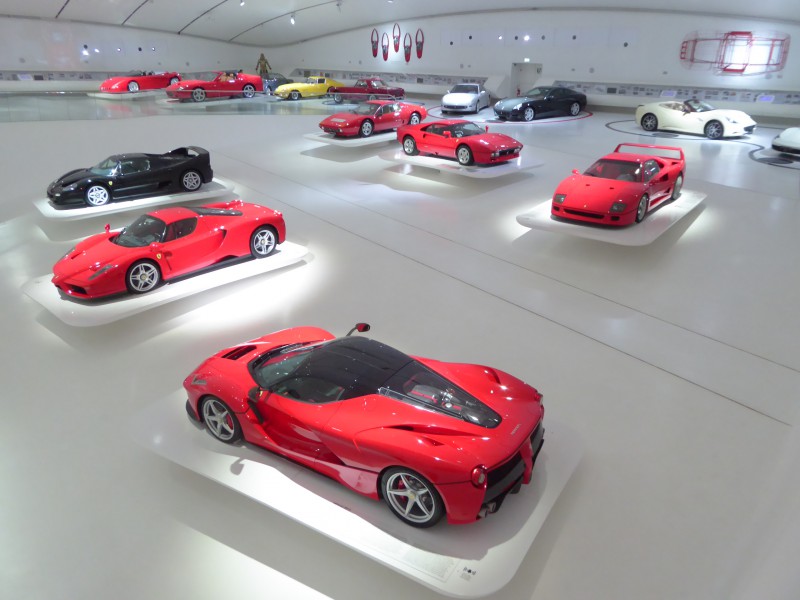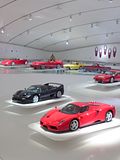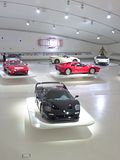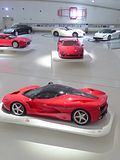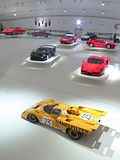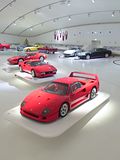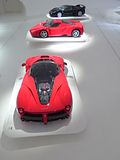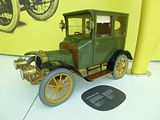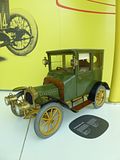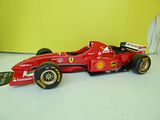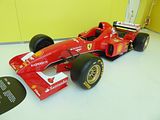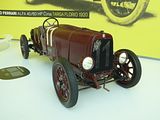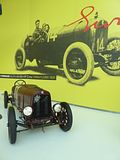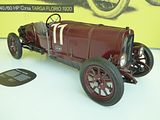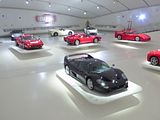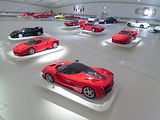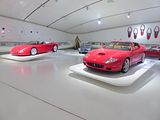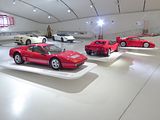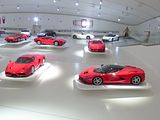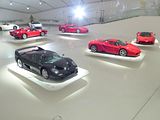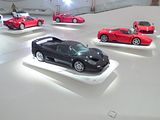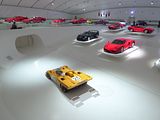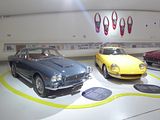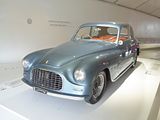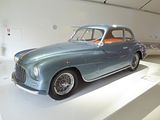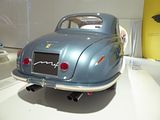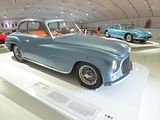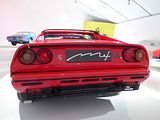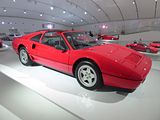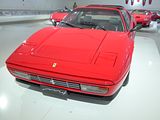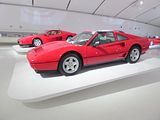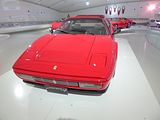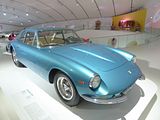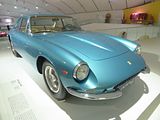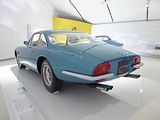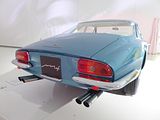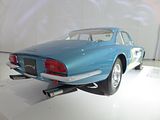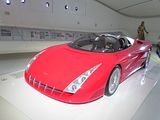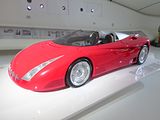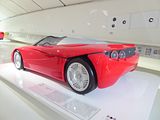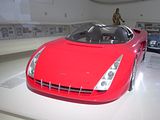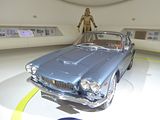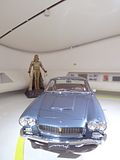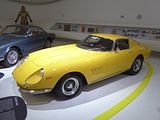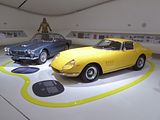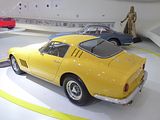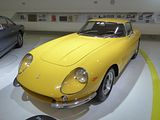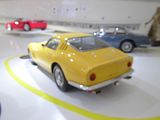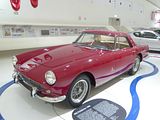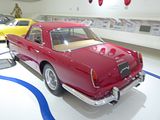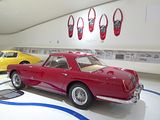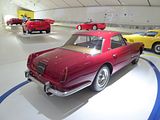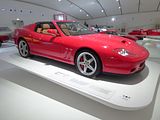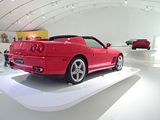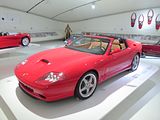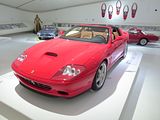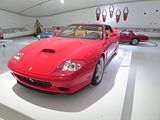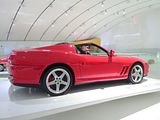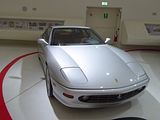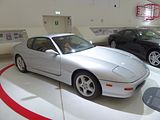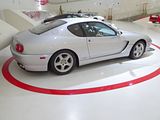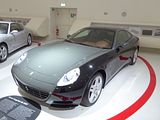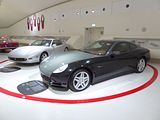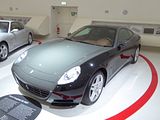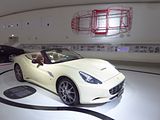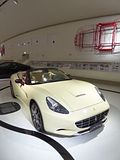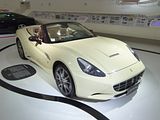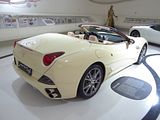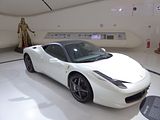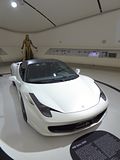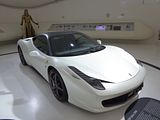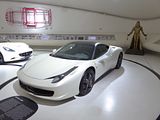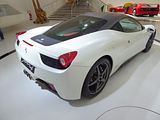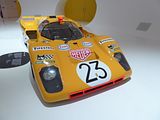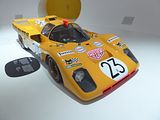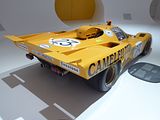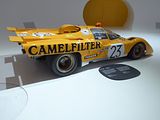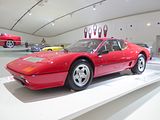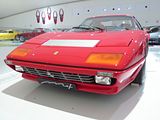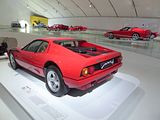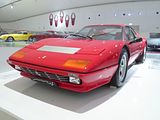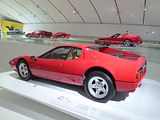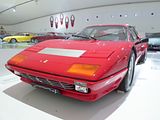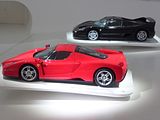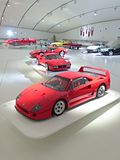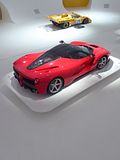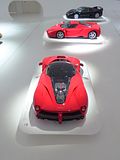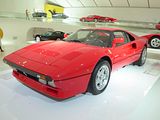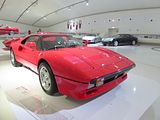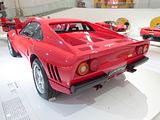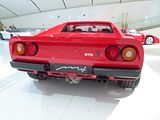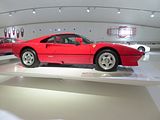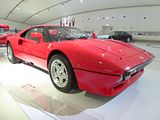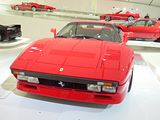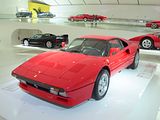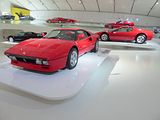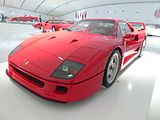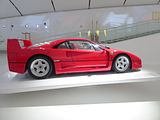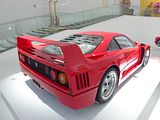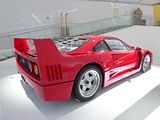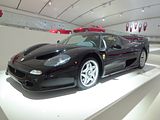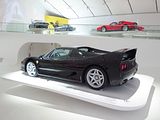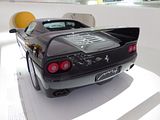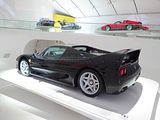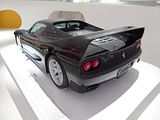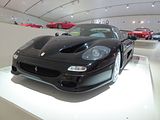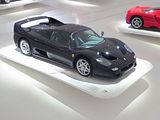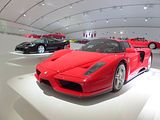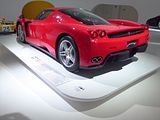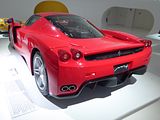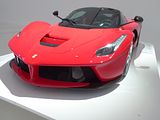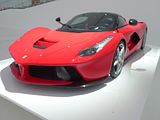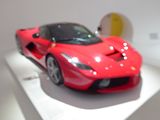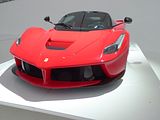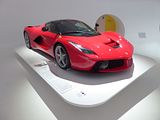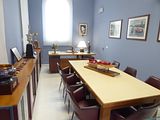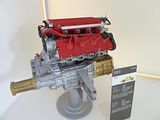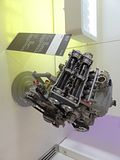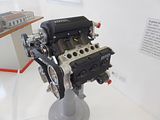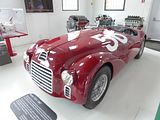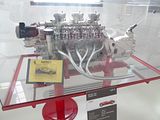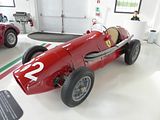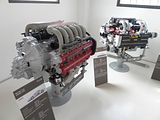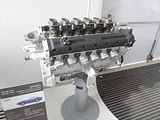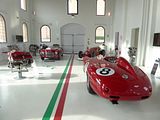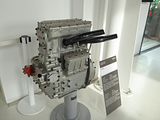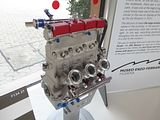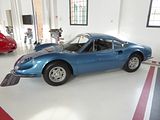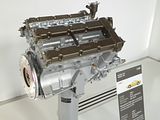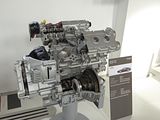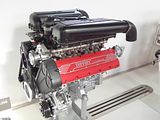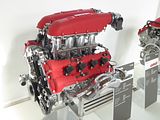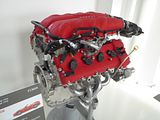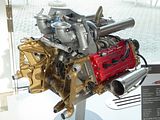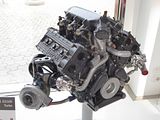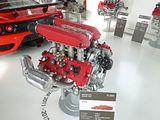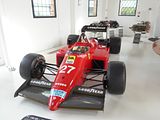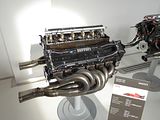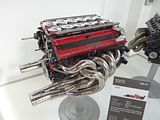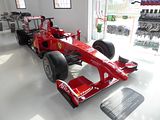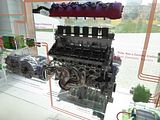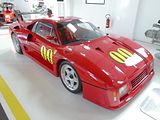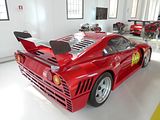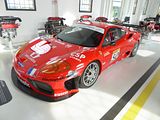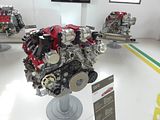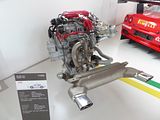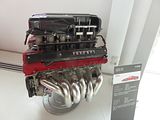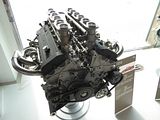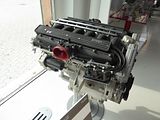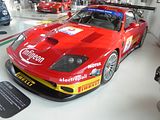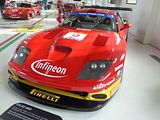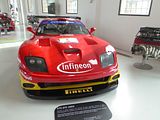It used to be the case with most museums, certainly car museums, that they were pretty static in terms of content and display. Pay a return visit even several years later and not only would you see the same content, but it had not even been moved around. Whilst there are still some which conform to this norm, most have realised that to get repeat visits, you have to offer something new. That can mean moving things around and finding new ways of displaying what you have, but in an increasing number of cases, it also means hosting temporary exhibitions. with content sourced either from the superset of material that there is space to display or borrowed to fill out a theme. It does mean that it is well worth fairly frequently reviewing any museum’s own website to see what changes and special exhibitions are planned, and trying to schedule those repeat visits. The policy of change in the display certainly applies to the museum under review here, the Casa Enzo Ferrari, situated in the centre of Modena. This October 2015 visit would be the third time I have stopped by in the past couple of years and there have been three completely different displays to marvel at. When you’re only displaying around 20 cars at a time, l guess it is not hard to have such a complete change around, and indeed the challenge that those planning the next exhibition face is probably more around what to leave out rather than what to include. In 2014, the Casa Enzo Ferrari hosted a special tribute to Maserati as the company celebrated its centenary, with a glorious tribute that I was able to see exactly twelve months before this trip. For 2015, the theme selected was “Ferrari in Pavarotti Land”. Not perhaps the most obvious choice, but the idea was to give visitors a fascinating glimpse into the encounter between two legendary men that although very different professionally, enjoyed the same incredible charisma, success, ambition and glory: Enzo Ferrari and Luciano Pavarotti. Ferrari was born in 1898, Pavarotti in 1935. The two men may have been separated by a 37-year age difference but both reached the pinnacle of their astonishing careers at the same time. When in the 1960s, Pavarotti was enjoying his first major successes on the opera stage, Ferrari, who had started designing and building cars under his own name in 1947, was establishing himself as an extraordinarily talented constructor, his racing cars triumphing in competition across the globe and his road-going models becoming a favourite with the international celebrity jet set. Working in collaboration with the Fondazione Luciano Pavarotti, the Museo Enzo Ferrari has staged an homage to the great tenor, choosing to exhibit only its most elegant road cars as these best reflected the sumptuousness of the opera stage.
Before you enter the main display area, there is an expansive foyer, with a Cafe at one end. At the other, there is space for three cars to be displayed and here they are:
This little 1903 De Dion Bouton is particularly significant as it belonged to the Ferrari family and in an era when cars were few and far between, would have been one of the inspirations for the young Enzo and his early interest in the automobile. Its 942cc engine generated 8HP which was enough to allow the car to reach 60 km/h.
Significant for a very different reason is this 1996 F310 Formula 1 car. This is the first Ferrari driven by the legendary Michael Schumacher. He had his first GP win for Ferrari in it in Spain, and victories in Belgium and Italy followed soon after. This was the beginning of a long and successful partnership between Ferrari and Schumacher.
Another significant marque in the story of Enzo Ferrari, of course, is Alfa Romeo. The young Enzo built his reputation on the team he ran that prepared and raced these cars in the 1930s, and it is said that although he always wanted to beat them once he had his own company, Enzo retained a huge affection and respect for the Milanese marque. Alfa built its reputation on racing in the 1920s and this is one of many cars from those glorious days. It is a 1921/22 Alfa Romeo G1, an evolution of the earlier 24HP and 40/60HP models. Its 6567cc generated 65hp, which gave it a top speed of the 120 km/h. This car won the Coppa del Garda.
You pass through something a bit like a cinema curtain to get into the main display. The reason for this is because about every 30 minutes, the lights dim, and a video is projected on the wall above the main entrance. It lasts about 10 minutes and covers the life of Enzo Ferrari and his legacy with some wonderful periodic footage. Needless to say the climax has the audio backing of Luciano Pavarotti singing Puccini’s famous “Nessum Dorma”. It is impossible not to be moved as the video reaches its climax saying “Grazie Enzo”. I’ve seen it several times now, and it still moves me greatly. And so to the cars on show. There are only around 20, each on its own plinth with just a brief description in Italian and English to tell you a little about what you are looking at. Around the perimeter of the building are display cases with fascinating artefacts from Ferrari’s history. There was no particular chronology to the way the cars were positioned around the main hall, so they are presented in the order in which I came to them.
Oldest car on show was the first one I came to. This is a 1948 166 Inter Touring Aerlux and is the car which was shown at the 1949 Torino Motor Show. The Ferrari 166 Inter was Ferrari’s first true grand tourer. An evolution of the 125 S and 166 S racing cars, it was a sports car for the street with coachbuilt bodies. The Inter name commemorated the victories claimed in 166 S models by Scuderia Inter. The 2.0 litre Gioacchino Colombo-designed V12 engine from the 166 S remained, as did its chassis, though the wheelbase would eventually grow from 2420 mm (95 in) to 2500 mm (98 in). Output was 110 to 140 hp at 6,000 rpm with one to three carburettors. The 166 Inter shared its Aurelio Lampredi-designed tube frame and double wishbone/live axle suspension and 2420 mm wheelbase with the 125 S and 166 S. The first Ferrari GT car debuted at the Paris Motor Show on October 6, 1949. It was an elegant coupe designed by Carrozzeria Touring of Milan who had previously created a number of similar Ferrari and Alfa Romeo models. Customer sales soon started, with 166 Inter models becoming the first Ferraris to be purchased for the road rather than the race track. As was typical at the time, a bare chassis was delivered to the coachbuilder of the customer’s choice. Many used Touring, but Ghia’s one-off Boano coupe was more daring. Others were built by Stabilimenti Farina, who penned a Cisitalia 202-like coupe. Vignale also joined in, presaging their designs of the coming decade, and two cabriolets created by Stabilimenti Farina and Bertone foreshadowed those companies’ later involvement with Ferrari. 37 166 Inters were built from 1948 through 1950 before the car was replaced by the 195 Inter and 212 Inter in 1950 and 1951. The car seen here has a Touring body and is Chassis number 55. Aerlux refers to the transparent panoramic roof which used technology developed for fighter planes in the Second World War.
Subject of many a poster on a young enthusiast’s bedroom wall when the car was new was the 1984 Testarossa. A replacement for the BB512i, the final iteration of Ferrari’s first ever mid-engined road car, the Testarossa was launched at the Paris Show in October 1984. The Pininfarina-designed car was produced until 1991, with the same basic design then going through two model revisions, with the 512 TR and later F512 M which were produced from 1992 to 1996 before the model was replaced by the front-engined 550 Maranello. Almost 10,000 Testarossas, 512 TRs, and F512 Ms were produced, making it one of the most-produced Ferrari models, despite its high price and exotic design. The Testarossa followed the same concept as the BB512, but was intended to fix some of the criticisms of the earlier car, such as a cabin that got increasingly hot from the indoor plumbing that ran between the front-mounted radiator and the midships-mounted engine and a lack of luggage space. This resulted in a car that was larger, and at 1,976 millimetres (78 in) wide the Testarossa was half a foot wider than the Boxer and immediately condemned for being too wide, though these days it does not appear anything like as wide as it did when new. This resulted in an increased wheelbase that stretched about 64 mm (2.5 in) to 2,550 mm (100 in) which was used to accommodate luggage in a carpeted storage space under the front forward-opening lid. The increase in length created extra storage space behind the seats in the cabin. Headroom was also increased with a roofline half an inch taller than the Boxer. The design came from Pininfarina with a team of designers led by design chief Leonardo Fioravanti, the designer of many contemporary Ferraris. The design was originated by Nicosia, but the guidance of Fioravanti was equally important. Being a trained aerodynamicist, Fioravanti applied his know-how to set the aerodynamics layout of the car. This meant the large side intakes were not only a statement of style but actually functional – they drew clean air to cool the side radiators and then went upward and left the car through the ventilation holes located at the engine lid and the tail. As a result, the Testarossa did not need a rear spoiler like Lamborghini’s Countach yet produced zero lift at its rear axle. The aerodynamic drag coefficient of 0.36 was also significantly better than the Lamborghini’s 0.42. Pininfarina’s body was a departure from the curvaceous boxer—one which caused some controversy. The side strakes sometimes referred to as “cheese graters” or “egg slicers,” that spanned from the doors to the rear wings were needed for rules in several countries outlawing large openings on cars. The Testarossa had twin radiators in the back with the engine instead of a single radiator up-front. In conjunction the strakes provided cool air to the rear-mounted side radiators, thus keeping the engine from overheating. The strakes also made the Testarossa wider at the rear than in the front, thus increasing stability and handling. One last unique addition to the new design was a single high mounted rear view mirror on the driver’s side. On US based cars, the mirror was lowered to a more normal placement in 1987 and quickly joined by a passenger side rear view mirror for the driver to be able to make safe easy lane changes. Like its predecessor, the Testarossa used double wishbone front and rear suspension systems. Ferrari improved traction by adding 10-inch-wide alloy rear wheels. The Testarossa drivetrain was also an evolution of the BB 512i. Its engine used near identical displacement and compression ratio, but unlike the BB 512i had four-valve cylinder heads that were finished in red. The capacity was 4,943 cc, in a flat-12 engine mid mounted. Each cylinder had four valves, lubricated via a dry sump system, and a compression ratio of 9.20:1. These combined to provide a maximum torque of 361 lb/ft at 4500 rpm and a maximum power of 390 hp at 6300 rpm. That was enough to allow the Testarossa to accelerate from 0–60 mph in 5.2 seconds and on to 100 mph. The original Testarossa was re-engineered for 1992 and released as the 512 TR, at the Los Angeles Auto Show, effectively as a completely new car, with an improved weight distribution of 41% front: 59% rear. The F512 M was introduced at the 1994 Paris Auto Show, with the M standing for “modificata”. That car is easy to spot as it lost the pop-up headlights and gained awkward glazed in units.
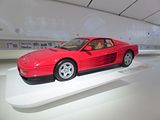
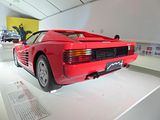
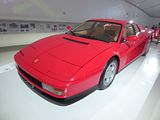
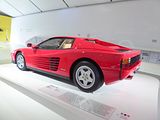
Introduced at the 1985 Frankfurt Show alongside the Mondial 3.2 series, the Ferrari 328 GTB and GTS (Type F106) were the successors to the Ferrari 308 GTB and GTS which had first been seen in October 1975. While mechanically still based on the 308 GTB and GTS respectively, small modifications were made to the body style and engine, most notably an increase in engine displacement to 3185 cc for increased power and torque output. As had been the case for a generation of the smaller Ferraris, the model name referred to the total cubic capacity of the engine, 3.2 litres, and 8 for the number of cylinders. Essentially the new model was a revised and updated version of the 308 GTS, which had survived for eight years without any radical change to the overall shape, albeit with various changes to the 3-litre engine. The 328 model presented a softening of the wedge profile of its predecessor, with a redesigned nose that had a more rounded shape, which was complemented by similar treatment to the tail valance panel. The revised nose and tail sections featured body colour bumpers integral with the valance panels, which reflected the work done concurrently to present the Mondial 3.2 models, with which they also shared a similar radiator grille and front light assembly layout. Thus all the eight-cylinder cars in the range shared fairly unified front and rear aspects, providing a homogeneous family image. The exhaust air louvres behind the retractable headlight pods on the 308 series disappeared, coupled with an increase in the size of the front lid radiator exhaust air louvre, which had been introduced on the 308 Quattrovalvole models, whilst a new style and position of exterior door catch was also provided. The interior trim also had a thorough overhaul, with new designs for the seat panel upholstery and stitching, revised door panels and pulls, together with more modern switchgear, which complemented the external updating details. Optional equipment available was air conditioning, metallic paint, Pirelli P7 tyres, a leather dashboard, leather headlining to the removable roof panel plus rear window surround, and a rear aerofoil (standard on Japanese market models). In the middle of 1988 ABS brakes were made available as an option, which necessitated a redesign of the suspension geometry to provide negative offset. This in turn meant that the road wheel design was changed to accommodate this feature. The original flat spoke “star” wheels became a convex design, in the style as fitted to the 3.2 Mondial models, whether ABS was fitted or not. The main European market 328 GTS models had a tubular chassis with a factory type reference F 106 MS 100. Disc brakes, with independent suspension via wishbones, coil springs, and hydraulic shock absorbers, were provided all round, with front and rear anti roll bars. There were various world market models, each having slight differences, with right and left hand drive available. The V8 engine was essentially of the same design as that used in the 308 Quattrovalvole model, with an increase in capacity to 3185 cc. The engine retained the Bosch K-Jetronic fuel injection system of its predecessor, but was fitted with a Marelli MED 806 A electronic ignition system, to produce a claimed power output of 270 bhp at 7000 rpm. As with the preceding 308 models the engine was mounted in unit with the all synchromesh five-speed manual transmission assembly, which was below, and to the rear of the engine’s sump. The 328 GTS continued in production for four years, until replaced by the 348 ts model in the autumn of 1989, during which time 6068 examples were produced, GTS production outnumbering the GTB (1344 produced) version almost five to one. Although this car has the body modifications of the 328, it is actually fitted with a 2 litre Turbo engine, which was produced primarily for the Italian market, where punitive taxation for engines over 2 litres made the Turbo car a fiscally appealing alternative.
This is a 1964 500 Superfast, one of a series of Ferrari models which are sometimes known as Ferrari America, as the inspiration to produce them came from America, as indeed did many of the initial customers, and some of them had America in their title. The 500 Superfast was really the end of this line, although it was followed by the 14 examples of the 365 California Spider which were built in 1967. Early in development, and even into production, these cars were to be called “Superamericas”, but the decision was made at the last moment to use “Superfast” instead. The engine was a 5.0 litre Ferrari Colombo V12 engine, generating 395 hp, making the car capable of 280 km/h (174 mph). The engine had the same dimensions as the Lampredi “long-block” engines of the 410 Superamerica, otherwise the design was based on the original Colombo ‘short’ block. The chassis was very similar in construction to the contemporary 330 GT 2+2, and bodywork was again done by Pininfarina. When leaving the factory, the 500 Superfast originally fitted Pirelli Cinturato 205VR15 tyres (CN72). 36 cars were made to 1966, including 12 “series II” models with an updated 5-speed transmission. Production total excludes a one-off 330 GT 2+2 produced with a Superfast-style body for HRH Prince Bernhard of The Netherlands. Only coupes were made and no Superfast roadsters were available. Needless to say, it was very costly when new, listing for more than twice the price of a Rolls Royce. Among the first owners were the Shah of Iran and Peter Sellers.
I confess I had to look at the display plaque to find out what this was. The answer is the F 100 Concept that was produced in 1998. Built to celebrate the 100th birthday of Il Commendatore, Enzo Ferrari, the F100 was conceived and designed by Leonardo Fioravanti and built for the 1998 Geneva motor show. It was designed to be a near-future mid-engine Ferrari coupe. The project was conceived as a surprise for the Ferrari team and family. As such, it was developed under the codename Priamo, the name of a famous king of Troy. But the name had nothing to do with Troy; it was actually a combination of the Italian words Primo and Amore – first love. Fioravanti had a long and successful career at Pininfarina where he worked extensively with Ferrari designing such classics as the Dino, the Daytona, 308GTB, the Testarossa, and many others. The F 100 was a coda of sorts for Fioravanti, his way of summing up a quarter-century of design thinking about what Ferrari should be. The proportions of the F100 were slightly different than many of its Ferrari predecessors. The F100 sported a longer, curving nose, an elongated wheelbase and a short tail, just barely enough to cover the rear wheels. Classic Ferrari design touches still featured, most notably the round tail lights – although, unusually, these used neon as the light source and were formed of free-standing hoops. The car’s bodyside was dominated by a character line that emerged from the headlights, and sliced across the bodyside to give emphasis to the flowing sheetmetal. The rear of the car also featured extendable air brakes which deployed upward from the rear deck and down from the rear bumper, doubling drag and increasing stability when braking from high speeds. Although the car was intended to be powered by a detuned version of Ferrari’s contemporary V10 Formula 1 engine, the interior was built more for comfort than speed. The seats were designed to keep each occupants whole body relaxed, and included integrated leg supports that, on the driver’s side, included the brake and throttle pedals. Shifting was done through F1-type paddle shifters that curved behind the steering wheel, while most of the car’s remaining controls were integrated into the wheel itself. As the car was intended to reach high cruising speeds, Fioravanti added digital and analogue instruments that were designed to be easier for the brain to process. The passenger compartment was covered by a retractable glass roof that slid between the engine’s roof-mounted air intakes. The mid-mounted engine could also be seen beneath a glass cover. Ten years after the F100 was first launched, and twenty years after Fioravanti’s design practice was was formed, a Japanese customer commissioned the firm to make a new design for a one-off Ferrari F430-based road car. Dubbed the SP1, it includes some elements of Fioravanti’s original design, although the modern reincarnation lacks much of what made the F100 such a fitting tribute to mark the occasion of 100 years since Enzo Ferrari’s birth.
Some would consider this an interloper, as it is not a Ferrari, but a Maserati Sebring. It was displayed along with a Ferrari, to make the point that these two cars were your choice if you wanted something Italian and exotic in 1964. The Sebring was a two-door 2+2 coupé made from 1962 until 1968. Based on the earlier Maserati 3500 GT, the Sebring was aimed at the American Gran Turismo market and named after Maserati’s 1957 racing victory at the 12 Hours of Sebring. A single two-seat spyder was built by Vignale in 1963 but did not enter production. What is now known as the Series I (Tipo AM 101/S) was shown at the Salon International de l’Auto 1962 and again at the Salone dell’automobile di Torino in 1963. Employing all but the Maserati 3500’s coachwork, it could reach 137 mph (220 km/h) and 0–60 mph in 8.5 seconds. A Borg-Warner automatic transmission was available, a first for Italian automobiles. The engine was updated in 1963, gaining 15PS for a total of 235 PS. The 3700 engine first appeared in 1964, although only a handful of Series I cars were thus equipped. A total of 348 Series I Sebrings were built between 1962 and 1965 at which pointed the Series II (Tipo AM 101/10) was introduced. It had lightly redesigned headlamps, modernised bumpers, new front indicators, and new side grilles replacing the lower extraction vents used hitherto. It took minor design cues from the contemporary Quattroporte. At the rear, aside from the squared off bumpers, the tail-lights were now mounted horizontally rather than vertically and the bootlid opening was narrowed somewhat. Along with the 3500 engine, the 3700 and the even larger 4000 were added. The 4000 GTiS had a 4,012 cc engine producing 255 PS. It remained in production until 1968, when financial constraints forced Maserati to drop its older models from production. No major updates took place over the last three years of production, except for a slight power gain for the 4000. 348 units of Sebring 3.5 and 245 of 3.7 and 4.0 (combined) were made, for a total of 593 units from 1962 to 1969.
Displayed with it was a Ferrari 275 GTB. one of those Ferrari models whose price tag generally runs into 7 figures when it is offered for sale these days. The 275 was a series of two-seat front-engined V12-powered models produced in GT, roadster, and spyder form by Ferrari between 1964 and 1968. The first Ferrari to be equipped with a transaxle, the 275 was powered by a 3286 cc Colombo 60° V12 engine that produced 280-300 hp. Pininfarina designed the GT and roadster bodies, Scaglietti the rare NART Spyder, among the most valuable of all Ferraris made. The standard 275 GTB coupe came first. It was produced by Scaglietti and was available with 3 or 6 Weber twin-choke carburettors. It was more of a pure sports car than the GT name suggested. Some cars were built with an aluminium body instead of the standard steel body. A Series Two version with a longer nose appeared in 1965. The 275 GTB/4 debuted in 1966. A much updated 275 GTB, it generated 300 bhp from a substantially reworked 3286 cc Colombo V12 engine, still with two valves per cylinder but now with a four-cam engine and six carburettors as standard. In a departure from previous Ferrari designs, the valve angle was reduced three degrees to 54° for a more-compact head. The dual camshafts also allowed the valves to be aligned perpendicular to the camshaft instead of offset as in SOHC engines. It was a dry-sump design with a huge 17 qt (16 litre) capacity. The transaxle was also redesigned. A torque tube connected the engine and transmission, rather than allowing them to float free on the body as before. This improved handling, noise, and vibration. Porsche synchronizers were also fitted for improved shifting and reliability. The 275 GTB/4 could hit 268 km/h (166.5 mph). With new bodywork, it was the first Ferrari to not be offered with wire wheels. A total of 280 were produced through to 1968 when it was replaced by the 365 GTB/4 Daytona.
Rather earlier than that was this 1958 250 Pininfarina one of 16 cars called 250. Debuting in 1958, the car came about as Ferrari needed series production to stabilise his company’s finances, so he asked Pininfarina to design a simple and classic 250 GT coupé. After the 250 GT Boano/Ellena, Pininfarina’s Grugliasco plant expanded and now had the capacity to produce the new 250 GT Coupé Pininfarina. It was introduced at Milan in 1958, and 335 near-identical examples were built by 1960. Buyers included Prince Bertil of Sweden. The GT Coupé eschewed the wing vents for simple, clean lines and a notchback look with panoramic rear window. The oval grille was replaced by a more traditional long narrow look with protruding headlights. Telescopic shock absorbers were also fitted instead of the Houdailles on previous 250s, and disc brakes were added in 1960. The original 165R400 Pirelli Cinturato tyres (CA67) were later changed to 185VR16. The final 250 GT Coupé had a Superfast tail and was shown at the 1961 London Motor Show.
Winding the clock on almost 40 years, and we come to the 575M Superamerica. Introduced in 2005, this was a convertible version of the 575M Maranello, Unlike the open topped version of the earlier 550 Maranello, the 550 Barchetta, which featured an incredibly primitive sort of roof covering, this one featured an electrochromic glass panel roof which rotated 180° (both are production car firsts) at the rear to lie flat over the boot. Patented Revocromico roof incorporates carbon fibre structure that is hinged on the single axis with a luggage compartment lid, allowing the access to the latter even with an open roof. With the roof open the rear window, apart for holding the third brake light, also acts as a wind deflector. This roof design was previously used on 2001-designed Vola by Leonardo Fioravanti. The Superamerica used the higher-output tune of the V-12 engine, F133 G, rated at 533 hp and Ferrari marketed it as the world’s fastest convertible, with a top speed of 199 mph (320 km/h). The GTC handling package was optional. A total of 559 Superamericas were built; this number followed Enzo Ferrari’s philosophy that there should always be one fewer car available than what the market demanded.
Pre-dating that car by a few years was this 456M. A front-engined grand tourer, the 456 was produced from 1992 until 2003, as an overdue replacement for the long-defunct front-engined 412 as the company’s V12 four seater. Pietro Camardella and Lorenzo Ramaciotti at Pininfarina designed the original 456 which was available in GT and from 1996 in GTA forms. The difference in name signifies the transmission: the former has a six-speed manual and the latter has a four-speed automatic developed in partnership with FF Developments, in Livonia, MI (which was later purchased by Ricardo Engineering in the UK). This was only the fourth automatic transmission ever offered by Ferrari. The 5473 cc 65° V12 engine was derived from the Dino V6 rather than the more conventional 60° V12s used in the 412 and Daytona. It produced 442 PS with 4 valves per cylinder and Bosch Motronic M2.7 engine management. It could push the 1690 kg car and four passengers to 302 km/h (188 mph) making it the world’s fastest production four-seater. Acceleration to 100 km/h was just 5.2 seconds, with a 13.4 second quarter-mile time. At the time of its development it was the most powerful road car ever developed by Ferrari (aside from the F40). In 1996 engine was changed with Motronic M5.2 management and typed as F116C. The name 456, as was Ferrari practice, came from the fact that each cylinder displaces 456 cubic centimeters. This was the last Ferrari to use this naming convention. Despite its supercar performance, the 456 has a relatively unstressed engine, which has proven to be a very reliable unit. The chassis is a tubular steel spaceframe construction with a one-piece composite bonnet and body panels of aluminium. The body panels are welded to the chassis by using a special “sandwich filler” called feran that, when laid between, allows steel and aluminium to be welded. The Modificata 456M appeared in 1998, starting with chassis number 109589. Many changes were made to improve aerodynamics and cooling, and the interior – still featuring Connolly Leather – was freshened with new seats and other conveniences (fewer gauges on dash, and a new Becker stereo fitted in front of gear stick rather than behind as in the very shallow and special Sony head unit in the 456 GT). The 456 has a smaller grille with fog lights outside the grille, and lacked the bonnet-mounted air scoops. The undercarriage spoiler on the 456M is fixed, where the older 456 had a motorised spoiler that began its deployment above 105 km/h (65 mph). Power remained unchanged on the Modificata using Bosch Motronic M5.2 engine management at 442 PS; the cylinder firing order was changed for smoother running, and the torque remained the same for later versions of the 456 GT. The Tour de France Blue with Daytona Seats was the most desirable colour and leather combination. Approximately 3,289 of all versions were built, consisting of: 456 GT: 1,548; 456 GTA: 403; 456M GT: 688; 456M GTA: 650.
Follow on to the 456 was the 612 Scaglietti, which adopted the same formula of a shapely body offering 4 seats and a potent V12 to power it, though the car never really found the favour you might have expected. On show here was a 2007 612 Scaglietti Sessanta, a limited production version of the regular 612 Scaglietti which was produced to commemorate the 60th anniversary of Ferrari. It included 19-inch forged aluminium wheels, black chrome exhaust tips, the automated manual F1 gearbox, three-position electrochromic glass roof, start/stop ignition button on the steering wheel, Bose entertainment unit and two-tone paint, for which there were tow choices: Grigio Scuro (dark grey, from Ferrari’s Colori Classici ’50-’60 vintage color palette)/Nero (black) with Grigio Scuro side line, as seen here, or Rubino Micalizzato (ruby red mica)/Nero Daytona (metallic black) with Rubino Micalizzato side line. Just 60 of these were made.
We then get on to some more familiar cars, starting with the 2008 California which was launched at the 2008 Paris Motor Show. According to industry rumours, the California originally started as a concept for a new Maserati, but the resulting expense to produce the car led the Fiat Group to badge it as a Ferrari in order to justify the high cost of purchase; Ferrari denies this, however. The California represented a new, fourth model range for the company, with a (slightly) lower purchase price. A two-door 2+2 hard top convertible, when originally released, it was powered by a front-mid mounted naturally aspirated 4.3-litre V8. In 2014 Ferrari introduced the second generation of the model, named California T and using a new twin-turbo 3.9-litre V8. The California represented a number of firsts for Ferrari: the first front engined Ferrari with a V8; the first to feature a 7-speed dual-clutch transmission; the first with a folding metal roof; the first with multi-link rear suspension; the first with direct petrol injection. With the top up, the California has a drag coefficient of Cd=0.32, making it the most aerodynamic Ferrari ever made until the introduction of the Ferrari F12 Berlinetta. The California was built on a new production line adjacent to the existing factory at Maranello, capable of producing 27 cars per day, or 6,000 per year. Throughout the California’s production, only 3 cars had been built with manual transmission, including one order from the UK. It became the last Ferrari to be offered with a manual gearbox.
Arriving a year later in the Ferrari range was the 2009 458 Italia. An all new design, the 458 Italia was first officially unveiled at the 2009 Frankfurt Motor Show. Once more, Ferrari advised that the model incorporated technologies developed from the company’s experience in Formula 1. The body computer system was developed by Magneti Marelli Automotive Lighting. The 458 came with a 4,499 cc V8 engine of the “Ferrari/Maserati” F136 engine family, producing 570 PS ( 562 hp) at 9,000 rpm and 540 N·m (398 lb/ft) at 6,000 rpm with 80% torque available at 3,250 rpm. The engine featured direct fuel injection, a first for Ferrari mid-engine setups in its road cars. The only transmission available was a dual-clutch 7-speed Getrag gearbox, in a different state of tune shared with the Mercedes-Benz SLS AMG. There was no traditional manual option, making this the fourth road-car after the Enzo, Challenge Stradale and 430 Scuderia not to be offered with Ferrari’s classic gated manual. The car’s suspension featured double wishbones at the front and a multi-link setup at the rear, coupled with E-Diff and F1-Trac traction control systems, designed to improve the car’s cornering and longitudinal acceleration by 32% when compared with its predecessors.The brakes included a prefill function whereby the pistons in the calipers move the pads into contact with the discs on lift off to minimise delay in the brakes being applied. This combined with the ABS and standard Carbon Ceramic brakes caused a reduction in stopping distance from 100–0 km/h (62-0 mph) to 32.5 metres. Ferrari’s official 0–100 km/h (62 mph) acceleration time was quoted as 2.9–3.0 seconds with a top speed of 340 km/h (210 mph). In keeping with Ferrari tradition the body was designed by Pininfarina under the leadership of Donato Coco, the Ferrari design director. The interior design of Ferrari 458 Italia was designed by Bertrand Rapatel, a French automobile designer. The car’s exterior styling and features were designed for aerodynamic efficiency, producing a downforce of 140 kg (309 lb) at 200 km/h. In particular, the front grille features deformable winglets that lower at high speeds, in order to offer reduced drag. The car’s interior was designed using input from former Ferrari Formula 1 driver Michael Schumacher; in a layout common to racing cars, the new steering wheel incorporates many controls normally located on the dashboard or on stalks, such as turning signals or high beams. At launch the car was widely praised as being pretty much near perfect in every regard. It did lack a fresh air version, though, but that was addressed with the launch of the 458 Spider at the 2011 Frankfurt Motor Show. This convertible variant of the 458 Italia featured an aluminium retractable hardtop which, according to Ferrari, weighs 25 kilograms (55 lb) less than a soft roof such as the one found on the Ferrari F430 Spider, and can be opened in 14 seconds The engine cover was redesigned to accommodate the retractable roof system. It had the same 0–100 km/h time as the hard-top but a lower top speed of 199 mph. It quickly became the better seller of the two versions.
Quite different from everything else on show was this 1970 512M, an out and out race car. It came about when the FIA changed the regulations of the Sport category to allow vehicles with 5-litre engines, up from the prior 3-litre capacity. Instead of 50 examples, only 25 examples needed to be produced to satisfy homologation rules. With the 917, Porsche had high hopes for capturing an overall victory at the gruelling 24 Hour of LeMans. Porsche had seen success with its 904, 907 and 908 race cars. These cars had done very well on the race track though some were plagued with mechanical difficulties and other growing pains which may have held them from realising their true potential. Porsche had not captured any overall wins at LeMans, just victories within their classes. Ferrari chose to use their pre-existing Formula 1 V-12 engine and created a prototype racer. Regulations for the prototype group restricted displacement to be no greater than three-litres. In 1969, the 312 P was constructed and ready for racing. It made its debut at Daytona, the season opener, where it easily captured pole position. At the end of the race, it had proven its abilities by finishing first in class. The 312 P continued to be raced until Porsche introduced their 917 at LeMans. The Porsche 917 was designed and built in 10 months and was powered by the Type 912 flat 12 engine of various displacement. As with most prototype vehicles, the 917 suffered from growing pains. The aerodynamics created low drag rather than down force and made the vehicle unstable at speeds. Though the 917 had been quick in practice, it had poor results during race day. After seeing the potential of the 917, Enzo Ferrari was inspired and began working on a GT racer. An engine was developed, named the Type 261, and followed closely with the already existing Formula 1 engine. It had a five-litre displacement size and a Lucas fuel injection system. The new engine was capable of producing 560 hpr which was later increased to 600. It was placed mid-ship and powered the rear wheels. Since it was not air cooled, it required a plethora of cooling pipes and a heavy radiator. With quad cams and four-valves per cylinder, the longitudinally mounted, 60-degree engine was ready to take on the Porsche 917. The chassis followed closely the design of the 312 P, but modified to carry the extra weight of the larger engine. The front section was an aluminium spaceframe with a rear subframe. The body was constructed of fibreglass and designed similar to its 312 P sibling. It weighed less than 900 kg. The chassis were numbered from 1002 to 1050, 19 were raced during the 1970 season. Though the 512 was more powerful than the 917, it lacked a couple of things, when compared to the Porsche. Due to using steel, reinforced with aluminium sheet, weight was about 100 kg’s more than the alloy-framed 917. The 917 had been introduced six months prior and had the benefit of being raced, tested, and its flaws identified. The 512 had a couple of months of testing, but had never been raced. Its shortcomings and weaknesses were unknown. Though this was a problem, it would not be an issue if the requirements for homologation were not meet. Ferrari had completed 17 examples and displayed parts for the remaining 8 cars. This was good enough to pass and five of the 512’s were entered into the Daytona 24 Hours. A 512 S driven by Mario Andretti had proven good enough to capture a pole position. At the completion of the race, Andretti had driven his 512 S to a fifth place finish, a respectable result but Enzo had been hoping for more. A failure in the suspension had dropped Andretti from a possible second place finish. During the final laps, he had to carefully negotiate the car around the course and continued to fall in the ranking. The other four Ferrari 512’s had experience mechanical problems and did not finish the race. The results were disappointing, but it did identify areas for improvement. The aerodynamics, power and handling had been good but more work could be done. The weight and fuel consumption were two of its biggest flaws. By removing the top, the weight was reduced by 25 kg’s. This was not a favourable solution for the drivers especially in bad weather. The fuel efficiency issues were addressed with an improved fuel injection system. The next championship race for the 512’s were at Sebring. Improvements and modifications had been made to the Ferrari’s, mostly the conversion to spyders for four of the five entrants. The car that had been driven by Andretti at Daytona had its original configuration. Andretti had managed to secure a pole position, and at the start of the race quickly emerged at the front of the pack. A pit stop sent him back into fourth place. At the end of the race, Andretti had captured the first victory with a Ferrari 512. Part of the success was attributed to mechanical problems with the Porsches, forcing many to retire. The season was far from over, with five championship races still remaining. During the remaining races, the 512 continued to be a strong contender, due in part to its excellent handling and its durability. Out of seventeen starts, only one retired prematurely. At Monza, the 512 had one of their best performances resulting in a second, third, and fourth place finish. The final race of the championship season was at LeMans. This twenty-four hour endurance race tests the drivers, teams, and the car. Its straight stretches favor vehicles with a high top speed. Porsche and Ferrari both created special longtail versions of the 512, hoping to reduce drag and increase the top speed. During practice for Porsche, the longtail versions had proven to be underdeveloped so they were reluctant to use them. The aerodynamics created by the longtails gave Ferrari an advantage but the extra 100 KG’s was a handicap. During qualifying, the 512’s proved to be fast and earned excellent positioning on the grid. The glorious season the 512 had endured up to this point was about to degrade. The claim-to-fame for the Ferrari’s had been their reliability which allowed them to finish. Just thirty minutes into the race, Vascarella was forced to retire his 512 S after major mechanical problems. The rain began to fall and two factory works cars were involved in accidents. The remaining 512 S works car managed to lead the pack until the early morning, when due to poor track conditions, it crashed, killing a marshal. When the checkered flag dropped, it was a Porsche in the lead. The season had shown that the 512 S was fast but more could be done to improve its performance. Work began on revising the car, and the result was dubbed the 512 M, meaning Modificato/Modified. 15 of the 25 vehicles were converted. Weight was reduced by nearly 40 kg’s, and the engine was improved to produce 620 horsepower. Air circulation was improved with the adoption of an airbox, which forced air into the engine. The inaugural race for the 512 M was at the 1970 championship race in Austria. Driven by Ickx and Giunti, the 512 M easily outpaced the 917s. Fuel and alternator problems meant the 512 M would not see the end of the race, but it had shown the capability of the car. For the 1971 season, Ferrari left the 512 M to be raced by customer teams. Ferrari focused their efforts on a 3-litreu prototype program, since many of the tracks favoured the smaller prototype racers. In the hands of the private customers, the 512 M was no match for the factory backed Porsche program. During the 1971 season, Porsche had won 8 of the 11 rounds of the Manufacturer World Championship. At the end of the 1971 season the Porsche 917 and Ferrari 512 had proven their abilities and supremacy that the FIA added new regulations that made them ineligible to race in world championships. Chassis number 1020 was converted at the end of the 1970 season to a 512M and sold to NART. Chassis number 1024 was converted to a 512M and sold to Scuderia Brescia Corse. 1036 was a test car used by the racing division of Ferrari and later sold to Solar Productions where it was featured in Steve McQueen’s movie, Le Mans. 1040 was sold to Chris Cord and Steve Earle of the United States and raced in the CanAm series. Due to its aggressive racing program and modifications that were made, it is probably the fastest and most advanced car of the series. It was run by Roger Penske and prepared in blue and yellow livery. Driven by Mark Donohue and David Hobbs, it was stricken with a string of bad luck and new had any good finishes. Its best was a third place finish at the 24 Hours of Daytona race. Chassis number 1046 was used for two things, the first being to aide in the homologation requirements, the second being a ‘parts car.’ Chassis number 1048 was sold as a test car to Filipinetti and not raced during the 1970 season. 1050 was sold in disassembled chassis and body configuration to Corrado Manfredini who later had it converted to a 512M and raced it during the 1971 season. Several of the 512S were destroyed in accidents, including 1012, a spyder which had crashed during practice at the ADAC 1000-KM on Nurburgring. 1026 was destroyed during the LeMans film.
Predecessor to the Testarossa was the Berlinetta Boxer and there was a 1981 BB512i example of the series on display. Production of the Berlinetta Boxer was a major step for Enzo Ferrari. He felt that a mid-engined road car would be too difficult for his buyers to handle, and it took many years for his engineers to convince him to adopt the layout. This attitude began to change as the marque lost its racing dominance in the late 1950s to mid-engined competitors. The mid-engined 6- and 8-cylinder Dino racing cars were the result, and Ferrari later allowed for the production Dino road cars to use the layout as well. The company also moved its V12 engines to the rear with its P and LM racing cars, but the Daytona was launched with its engine in front. It was not until 1970 that a mid-engined 12-cylinder road car would appear.The first “Boxer” was the 365 GT4 BB shown at the 1971 Turin Motor Show. Designed to rival the Lamborghini Miura and the newly developed Lamborghini Countach, it was finally released for sale in 1973 at the Paris Motor Show. 387 were built, of which 88 were right-hand drive (of which 58 were for the UK market), making it the rarest of all Berlinetta Boxers. The Pininfarina-designed body followed the P6 show car with popup headlights. Though it shared its numerical designation with the Daytona, the Boxer was radically different. It was a mid-engined car like the Dino, and the now flat-12 engine was mounted longitudinally rather than transversely. Although referred to as a Boxer, the 180° V12 was not a true boxer engine, but rather a flat engine. It had 380 hp, slightly more than the Daytona. The 365 GT4 BB was updated as the BB 512 in 1976, resurrecting the name of the earlier Ferrari 512 racer. The name 512 referred to the car’s 5 litre, 12 cylinder engine; a deviation from Ferrari’s established practice of naming 12-cylinder road cars (as the 365 BB) after their cylinder displacement. The engine was enlarged to 4943.04 cc, with an increased compression ratio of 9.2:1. Power was slightly down to 360 hp, while a dual plate clutch handled the added torque and eased the pedal effort. Dry sump lubrication prevented oil starvation in hard cornering. The chassis remained unaltered, but wider rear tires (in place of the 365’s equally sized on all four corners) meant the rear track grew 63 mm. External differentiators included a new chin spoiler upfront, incorporated in the bumper. A NACA duct on the side provided cooling for the exhaust system. At the rear there were now twin tail lights and exhaust pipes each side, instead of triple units as on the 365 GT4 BB. 929 BB 512 models were produced. The Bosch K-Jetronic CIS fuel injected BB 512i introduced in 1981 was the last of the series. The fuel injected motor produced cleaner emissions and offered a better balance of performance and daily-driver temperament. External differentiators from the BB 512 besides badging include a change to metric sized wheels and the Michelin TRX metric tyre system, small white running lights in the nose, and red rear fog lamps outboard of the exhaust pipes in the rear valance. 1,007 BB 512i models were produced.
The final series of cars in here were one each of the last 5 special models which we tend now to think of as Hypercars. It is not often you get to see all 5 in one place and certainly not displayed as brilliantly as this. It would be a hard man who said that the entry fee was not worth it just to see these 5 cars alone!
First of these, and still my personal favourite, was the 1984 288 GTO. The GTO was built to compete in the new Group B Race series and a minimum of 200 cars were required for homologation. However, after the death of Henri Toivonen and his co-driver Sergio Cresto in the 1986 Tour de Corse, the FIA disestablished the class, leaving just the Group A Rally championship. As a result, the GTO never raced and all 272 cars built remained purely road cars. Some of the GTO’s styling features were first displayed on a 308 GTB design exercise by Pininfarina shown at the 1977 Geneva Salon. The 288 GTO started out as a modified version of the 308/328 to hold down costs and to build the car quickly, but little of the 308/328 was left when the 288 GTO was finished. Easily noticeable differences were the GTOs bulging wing flares, larger front/rear spoilers, large “flag-style” outside mirrors and four driving lights at the far sides of the grille. Retained from the original 250 GTO were slanted air vents, put in the GTO’s rear wings to cool the brakes. The GTO also had wider body panels than the 308’s because they had to cover much larger Goodyear tyres mounted on racing wheels. The suspension’s height could be set higher for road use and lower for racing on tracks. Bodywork material was new and lighter for better acceleration and handing. The GTO’s weight was only 2,555 pounds, compared to 3,085-3,350 for the 308/328. Steel was used just for the doors because major body panels were made from moulded fibreglass. Kevlar was used for the engine cover, and the roof was made from Kevlar and carbon fibre. The “288” refers to the GTO’s 2.8 litre V8 engine as it used a de-bored (by 1 mm) V8 with twin IHI turbochargers, intercoolers, and Weber-Marelli fuel injection. The 2855 cc engine capacity was dictated by the FIA’s requirement for a Turbocharged engine’s capacity to be multiplied by 1.4. This gave the GTO a theoretical engine capacity of 3997 cc, just under the Group B limit of 4.0 litres. Unlike the 308’s 2926 cc engine, the GTO’s 2855 cc engine was mounted longitudinally, using the 308’s rear boot space. This was necessary to make room for the twin turbochargers and intercoolers. The racing transmission was mounted to the rear of the longitudinal engine, moving the rear differential and wheels aft. The arrangement also let the GTO use a more conventional race-car engine/transmission layout for such things as quick gear ratio changes for various tracks. As a result, the wheelbase was 110 mm (4.3 in) longer at 2,450 mm (96 in). The track was also widened to accommodate wider wheels and tyres to provide increased cornering and braking performance and the ability to apply 400 hp and 366 lb·ft of torque to the ground. The GTO was an impressive performer, with 0-60 mph times around 5 seconds. Ferrari claimed 0-125 mph (201 km/h) in 15 seconds flat and a top speed of 189 mph (304 km/h), making it the first street-legal production car to reach 300 km/h.
The F40 of 1987 was the successor to the 288 GTO. It was designed to celebrate Ferrari’s 40th anniversary and was the last Ferrari automobile personally approved by Enzo Ferrari. At the time it was Ferrari’s fastest, most powerful, and most expensive car for sale. As soon as the 288 GTO was launched, Ferrari started the development of an evolution model, intended to compete against the Porsche 959 in FIA Group B. However, when the FIA brought an end to the Group B category for the 1986 season, Enzo Ferrari was left with five 288 GTO Evoluzione development cars, and no series in which to campaign them. Enzo’s desire to leave a legacy in his final supercar allowed the Evoluzione program to be further developed to produce a car exclusively for road use. In response to the quite simple, but very expensive car with relatively little out of the ordinary being called a “cynical money-making exercise” aimed at speculators, a figure from the Ferrari marketing department was quoted as saying “We wanted it to be very fast, sporting in the extreme and Spartan,” “Customers had been saying our cars were becoming too plush and comfortable.” “The F40 is for the most enthusiastic of our owners who want nothing but sheer performance. It isn’t a laboratory for the future, as the 959 is. It is not Star Wars. And it wasn’t created because Porsche built the 959. It would have happened anyway.” Power came from an enlarged, 2936 cc version of the GTO’s twin IHI turbocharged V8 developing 478 bhp. The F40 did without a catalytic converter until 1990 when US regulations made them a requirement for emissions control reasons. The flanking exhaust pipes guide exhaust gases from each bank of cylinders while the central pipe guides gases released from the wastegate of the turbochargers. Engines with catalytic converters bear F120D code. The suspension was similar to the GTO’s double wishbone setup, though many parts were upgraded and settings were changed; the unusually low ground clearance prompted Ferrari to include the ability to raise the vehicle’s ground clearance when necessary. The body was an entirely new design by Pininfarina featuring panels made of Kevlar, carbon fibre, and aluminium for strength and low weight, and intense aerodynamic testing was employed. Weight was further minimised through the use of a plastic windscreen and windows. The cars did have air conditioning, but had no sound system, door handles, glove box, leather trim, carpets, or door panels. The first 50 cars produced had sliding Lexan windows, while later cars were fitted with wind down windows. The F40 was designed with aerodynamics in mind. For speed the car relied more on its shape than its power. Frontal area was reduced, and airflow greatly smoothed, but stability rather than terminal velocity was a primary concern. So too was cooling as the forced induction engine generated a great deal of heat. In consequence, the car was somewhat like an open-wheel racing car with a body. It had a partial undertray to smooth airflow beneath the radiator, front section, and the cabin, and a second one with diffusers behind the motor, but the engine bay was not sealed. Nonetheless, the F40 had an impressively low Cd of 0.34 with lift controlled by its spoilers and wing. The factory never intended to race the F40, but the car saw competition as early as 1989 when it debuted in the Laguna Seca Raceway round of the IMSA, appearing in the GTO category, with a LM evolution model driven by Jean Alesi, finishing third to the two faster spaceframed four wheel drive Audi 90 and beating a host of other factory backed spaceframe specials that dominated the races. Despite lack of factory backing, the car would soon have another successful season there under a host of guest drivers such as Jean-Pierre Jabouille, Jacques Laffite and Hurley Haywood taking a total of three second places and one third. It would later be a popular choice by privateers to compete in numerous domestic GT series. Although the original plan was to build just 400 cars, such was the demand that in the end, 1311 were built over a 4 year period.
Fans who wanted to see what Ferrari would do next did not have too long to wait, as the next hypercar, the F50 appeared 4 years later, in 1995. This could almost be seen as a Formula 1 car for the road, as this mid-engined two seat roadster with a removable hardtop had a 4.7 litre naturally aspirated 60-valve V12 engine that was developed from the 3.5 litre V12 used in the 1990 Ferrari 641 Formula One car. Only 349 cars were made, of which 301 were red. Just 4 of them were black, making it, along with silver the least produced colour of the limited palate offered. The last F50 was produced in July 1997. These days this is the rarest of the quintet.
There was a bigger gap before the next car came along. Widely rumoured to be called the F60, Ferrari surprised everyone at its 2002 unveiling by giving it the name Enzo. This car was built using even more Formula One technology, such as a carbon-fibre body, F1-style electrohydraulic shift transmission, and carbon fibre-reinforced silicon carbide (C/SiC) ceramic composite disc brakes. Also used were technologies not allowed in F1 such as active aerodynamics and traction control. After a downforce of 7600 N (1700 lbf) is reached at 300 km/h (186 mph) the rear wing is actuated by computer to maintain that downforce. The Enzo’s F140 B V12 engine was the first of a new generation for Ferrari. It was based on the design of the V8 found in Maserati’s Quattroporte, using the same basic design and 104 mm (4.1 in) bore spacing. The Enzo formed the basis for a whole array of other very special cars, including the FXX and FXX Evoluzione cars and the Maserati MC12 and MC12 Evoluzione as well as the Ferrari P4/5 and the Millechilli. Originally, 349 of these were going to be produced, but Ferrari decided to add another 50 to the total, meaning 400 in total were produced up until 2004.
If you wanted the next in the series, the 2013 LaFerrari, it was almost a pre-requisite that you had bought one of all the others, and probably a few other Ferraris as well. Launched at the 2013 Geneva Show, along with the Porsche 918 Spyder and McLaren P1, the LaFerrari has the distinction of being the first mild hybrid from Ferrari, which ensures that as well as providing the highest power output of any Ferrari, fuel consumption can be decreased by up to 40 percent. Owners may not care, but regulators certainly do! LaFerrari’s internal combustion engine is a mid-rear mounted Ferrari F140 65° V12 with a 6262 cc capacity producing 800 PS (789 bhp) @ 9000 rpm and 700 N·m (520 lbf·ft) of torque @ 6,750 rpm, supplemented by a 163 PS (161 bhp) KERS unit (called HY-KERS), which will provide short bursts of extra power. The KERS system adds extra power to the combustion engine’s output level for a total of 963 PS (950 bhp) and a combined torque of 900 N·m (664 lb·ft). Ferrari claims CO2 emissions of 330 g/km. It is connected to a 7-speed dual-clutch transmission and the car is rear-wheel drive. 499 units were built, each costing over $1million.
Right next to the main museum is a separate building, which is actually the reason why the museum is here as opposed to elsewhere in Modena. This is the actual house and workshop of the Ferrari family, and as such is where young Enzo grew up. It has been restored and now houses a further collection of interesting items – a mix of cars and engines, as well as some other Ferrari memorabilia.
On the right as you wind around the corridor to get to the workshop area is a recreation of Enzo’s office, with many genuine artefacts that he had used and would have around him as he ran his company.
The majority of the exhibits in the old workshop area are engines. I found these fascinating, as when you look at them, you can see how every one is very different from every other. Those who might have thought that as Ferrari’s engines got more powerful, it was simply a case of larger capacity and more efficiency can see that every single one is a completely different design. As well as engines from familiar production cars, there were a number of units included which never made production, engines where something new was tried but for various reasons never made it into a commercially available product, or racing car.
The 1987 F117A was an experimental 4 litre V8 designed for a 4WD prototype car that was quite widely photographed whilst under development but which never made production.
1989 F119A – a 3.4 litre unit used in the 348tb
F135A – 4.7 litre two x V6, only 6 combustion chambers. Experimental
This is the very first ever Ferrari, the 1947 125S. Although preceded by Enzo Ferrari’s Auto Avio Costruzioni 815 of 1940, the 125 S was the first vehicle to bear the Ferrari name when it debuted on May 11, 1947 at the Piacenza racing circuit. Like the 815, it was a racing sports car, but unlike its Fiat-powered 8-cylinder predecessor, the 125 S featured a V12 engine (the “125”), a trait it shared with most Ferrari cars of the following decades. Only 2 were built before the 125 S would be replaced by the 159 S later in the year. The 125 S used a steel tube-frame chassis and had a double wishbone suspension with transverse leaf springs in front with a live axle in the rear. Hydraulic power drum brakes were specified front and rear. It was powered by Gioacchino Colombo’s 1497 cc 60° V12, which produced 118 bhp at 6,800 rpm . This was a single overhead camshaft design with 2 valves per cylinder and three double-choke Weber 30DCF carburettors. Enzo Ferrari wanted the 125 S to use a five-speed gearbox as it matched the high revving V12 better than that of a traditional four-speed gearbox. The 125 S debuted at the Circuito di Piacenza, driven by Franco Cortese, but was unable to finish the race, despite a favourable showing against the strong Maserati 6CS 1500s. Two weeks later, the 125 S claimed Ferrari’s first victory at the Grand Prix of Rome on the Terme di Caracalla Circuit, where it was also driven by Cortese. The car had spun a bearing in practice, and was repaired in the workshop of Tino Martinoli, who later came to America with the Ferrari Indy car team. The 125 S won six of its fourteen races in 1947, though drivers Clemente Biondetti and Giuseppe Navone were unable to win the 1947 Mille Miglia in it. Both of the two 125 S cars built in 1947 were dismantled, and their parts are thought to have been re-used in production of the 159 or 166 models. Recently, the chassis with serial number 010I was used in the restoration of a 125 S. It is rumored that 010I is actually s/n 01C. The story goes that 01C was re-stamped as 010I, and sold to a customer as a new car. Upon taking receipt of the car, the new owner immediately exclaimed, muletto!, which means “Test mule” in Italian, as he could clearly see that his supposedly new car was in fact a used, well-raced car. Ferrari made a new invoice for the car, including a considerable rebate given the car’s second-hand nature. Still in 166 Spyder Corsa configuration, the car was sold to Symbolic Motors. Close inspection of the chassis and its serial number led to the discovery of an old stamping that could possibly read 01C. It had been covered by an aluminium plate which bore the serial number 010I. Subsequently, the car was sold to its current owner, who refitted the chassis with a body similar to the factory’s 125 S replica, which was built by Michelotto in 1987. The alleged 01C made its public debut at the Pebble Beach Concours d’Elegance, and was entered as a “Ferrari 125 S”. The car continues to be the subject of much debate among Ferrari historians and enthusiasts; recent developments indicate that the restamped serial number was in fact a correction and not an alteration.
This is a Ferrari 500, a Formula 2 racing car designed by Aurelio Lampredi and used by Ferrari in 1952 and 1953. For 1952, the FIA announced that Grand Prix races counting towards the World Championship of Drivers would be run to Formula 2 specification rather than to Formula 1, after the withdrawal of Alfa Romeo from the sport. Ferrari were the only team to have a car specifically designed for the new formula. The car was powered by an inline four-cylinder engine which was mounted behind the front axle, improving weight distribution. Alberto Ascari used the car to win his first world championship, winning all but one race with the simple 500. The race he missed was because he was driving the 4.5-litre Ferrari at the Indianapolis 500, however Ferrari won the race he was absent from as well. The following season, Ascari won his second world championship, and Ferrari won all but the final race, which was won by Juan Manuel Fangio, back in racing after an accident which had damaged his neck. Ascari won seven consecutive World Championship races in the 500, a record which stood until Sebastian Vettel broke it in 2013. If the 1953 Indianapolis 500 (which was run to a different formula, and in which Ascari was not entered) is discounted, the run is extended to nine.
F113A from the Testarossa
This 243/251 is a prototype 3 valves per cylinder engine conceived potentially for the Daytona, but not put into production
During the 1950s, Ferrari produced a constant stream of new cars for the race track, and telling them apart can be quite difficult as there was something of an evolution rather than completely new designs that emerged from Maranello. 1953 had been a breakout year for Ferrari, beginning with the new World Sportscar Championship series. The company augmented their traditional V12-powered 250 MM with the new 340 MM and 375 MM and introduced the new four-cylinder 625 TF and 735 S models. With this profusion of cars, Ferrari was able to sweep the first running of the sportscar championship. The 1954 and 1955 seasons were the heyday of the four-cylinder Ferrari sports racer. The company hit its stride, earning the World Sportscar Championship in 1954 and contending in 1955 despite the legendary Mercedes-Benz team. Success came with the 2 litre 500 Mondial and this car, a 1954 750 Monza. It used a three-litre version of the 500 Mondial’s engine, which meant it was much more powerful, with 250 hp available, but barely heavier at 760 kg (1675 lb). The new-style body was penned by Pinin Farina and presaged the droop-nose look of the famed 250 GTO, but it was Scaglietti’s 750 Monza, with its faired-in headrest suggesting the flowing Testa Rossa that drew attention. Sadly, Alberto Ascari was killed in the car during an impromptu testing session at Monza in 1955. Mike Hawthorn and Umberto Maglioli piloted their 750 Monza to victory at Monza on its very first race, giving the car its name. Although they were strong on the track, the Monza was unable to hold off the Mercedes-Benz 300 SLR in 1955, allowing the Germans to seize the sports car championship that Ferrari claimed in 1954. Further advances and more power came in 1956 with the the 860 Monza which had a 3.4 litre engine and the new 290 MM showed well, too bringing the sports car world championship home to Modena again. This was despite the fact that Jaguar’s new D-Type took the crown at the newly restricted Le Mans and Maserati’s 300 S took the 1000km Nürburgring race.
Ferrari were also busy in Formula 1 at this time, and this is their 1955 entrant, the 625. The 1955 Formula One season was the sixth season of FIA Formula One motor racing. It featured the 1955 World Championship of Drivers, which commenced on 16 January 1955 and ended on September 11 after seven races. Juan Manuel Fangio won his second consecutive World Championship title in a season that was curtailed by tragedies. As a result, the season also included a number of non-championship Formula One races. Mercedes drivers again dominated the championship, with Fangio taking four races, and his new team mate Stirling Moss the British Grand Prix. Ferrari won at Monaco only after all of the Mercedes cars broke down and Lancia driver Alberto Ascari crashed into the harbour. Although Ascari was apparently unscathed, the double World Champion crashed fatally at Monza while testing sportscars four days later. There were only 7 races in the championship that year.
F134 – an in-line 6 in two banks of 3 cylinders
This is the 1967 135B for the Dino 206 GT and displayed alongside it was the car it went in. The Ferrari Dino was created to honour Alfredo ‘Dino’ Ferrari, Enzo Ferrari’s only legitimate son, who sadly died of muscular dystrophy in 1956. Unlike any previous road-going Ferrari, the Dino utilised a V6 engine, the Tipo 156, which Alfredo himself had helped develop and strongly advocated during his working life. Following continued motor racing success and in order to homologate Ferrari’s 1966 Formula Two campaign, a new line of mid-engined production V6 coupés with Fiat running gear went on sale in 1967 in two litre 206 GT form. However, in 1969 a larger 2.4 litre Dino was introduced, named the 246 GT or GTS in the case of the Spider. Only 3,913 definitive Dinos were built before the introduction of the completely restyled V8 engined 308 in 1973
1982 F105A for the 308 GTB Qv
F129B – the 5 valve per cylinder 3.5 litre V8 used in the F355 plus its new F1 style gearbox
F131B for the 360 Modena

F136E for the F430
F136IH for the 2008 California
1981 F1 engine for the 126CK – tested with a Comprex supercharger, but not used in races
1987 033D
2009 F136H for the 458 Italia
1985 F1 156 – Alboreto World Championship
1995 044
1990 036
1989 035/5
1974 015
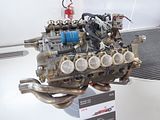
2006 056

2004 053
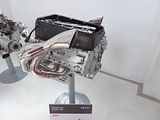
1996 046/1
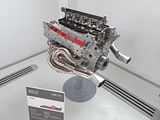
This the 2009 F60 Formula 1 car, the 55th single-seater car produced by Ferrari to compete in Formula One, and first launched online on 12 January 2009. The car was named F60 to celebrate the fact that 2009 was Ferrari’s 60th year in Formula One, the only team to have competed every year. Felipe Massa undertook the debut run of the car with a shakedown at Mugello later that day. The car was initially intended to debut at Ferrari’s home Fiorano track, but the venue was changed due to poor weather conditions at Maranello. On average, the Ferrari F60 was 1.9 seconds faster than the last car, despite the new regulations. In the 2009 season, FIA banned the large bargeboards in front of the radiator and the sidepods. It also placed limits on the wheelbase, making it shorter, simpler front splitter, narrower rear spoiler and certain underside air flows, so that it is less disruptive to the car behind. The Ferrari F60 responded to all of this by improving tiny details from the F2008. The front splitter is located further away from the front wheel, and now had only 1 layer. Ferrari claimed this improved air flow to the wheels. The F60 was only fitted with 1-tread slick tyres, and a simpler suspension positioned a bit backward in angle. Ferrari removed the large airflow plates and replaced it with a small one, also adjusting some underside air flow. The side mirrors were located at the edge of the car’s floor. The FIA’s ban on small side wings led to the creation of a “cleaner” sidepods acceptable of the smaller engine, and a smooth underside of the chassis. The rear diffuser was revised to meet the regulations that stated it had to produce less downforce. The F60 scored its first points in Bahrain, the fourth race of the season. Kimi Räikkönen finished sixth, gaining three points for Ferrari. They had scored points at each race since. Felipe Massa had an accident in the Hungarian Grand Prix involving a spring from Rubens Barrichello’s Brawn GP car falling off and striking him on his helmet. He did not start the race and for the rest of the season, he was replaced by Ferrari test driver, Luca Badoer and ex-Force India driver Giancarlo Fisichella. The F60 won its first and only race of 2009 at the hands of Räikkönen at the Belgian Grand Prix, after starting 6th on the grid. They eventually finished fourth in the constructors standings, just behind McLaren, and making 2009 the worst season for Ferrari since 1993. Räikkönen was Ferrari’s highest points scoring driver in 2009, finishing sixth in the standings with 48 points, one adrift of fifth-placed Lewis Hamilton of McLaren. In early August 2009 Ferrari announced that they had stopped developing the F60 in order to concentrate on the 2010 car.
The LaFerrari engine
Also built for racing was the 1953 Arno XI Ferrari Hydroplane. Built for the 800kg racing class, it claimed a World Speed Record of 241.708 km/h in 1953, using its 4493cc V12 Ferrari engine which was derived from a unit that powered Formula 1 cars of the era.
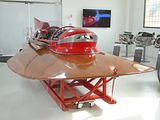
Dating from 1986 is this GTO Evoluzione. Ferrari built five of these cars, with more aggressive and aerodynamic body styling and increased power. The engine in the 288 GTO Evoluzione originally put out as much as 650 hp. With weight of 940 kg (2,072 lb) the car had a top speed of 225 mph (362 km/h). These cars form the clearest visual link between the 288 GTO and the F40 soon to follow. All five are still in existence with this one owned by the Factory.
Ferrari produced a series of 360 Modena based cars for the track and this one, dating from 2004, the 360 GTC was the last of the line. It replaced the previous 360 GT. With a dry weight of 1100 kg, it was built by Ferrari Corse Clienti department in collaboration with Michelotto Automobili to compete in the N-GT class. It made use of recent evolutions successfully race tested on the Ferrari 360 GT, with a sequential six-speed gearbox and a further improved Magneti Marelli electronics package. The aerodynamics were substantially different from the 360 GT, as the 360 GTC was homologated by FIA/ACO from the Challenge Stradale, using its basic elements: front bumper, side skirts, engine cover and double rear end. Wind tunnel research led to a new system for the rear wing, with a notable improvement in vertical downforce. The performance of the 90-degree V8 3586 cc engine was improved. Whilst the 360GT had a power output of 445 hp, the GTC bettered that, at 472 bhp while still breathing through the mandatory 30.8 mm air restrictors. (Without the mandatory for racing in N-GT class air restrictors in place, the engine dyno-ed at an astonishing 550 bhp).and the car had better fuel consumption. In 2009 a privately owned Veloqx-Prodrive Racing 360 raced de-restricted, fully tuned variations of the GT-C in endurance races around the world including; Silverstone, Sebring and Le-Mans.
2015 F154B as used in the California T
The 1987 F120A from the F40
The 1982 F106D used in the 208 GTB Turbo
The 2002 F140B for the Enzo
The F50, for the F50
And this F116A was a 5.2 litre V12 unit
In 2003, Ferrari announced the sale of several 575M-based racing cars, known as the 575 GTC (not to be confused with the 575M GTC Handling Package). Following the success of Prodrive in running the Ferrari 550, Ferrari wished to offer their own racing car to customers. Used primarily in the FIA GT Championship, the 575 GTCs managed to take a single win in their first season, followed by another lone win in 2004. Unfortunately the 575 GTCs were not as capable as the Prodrive-built 550 GTSs, and would fall from use by the end of 2005.
This is an incredible place. There may be only 20 cars on show, but it is well worth the entry fee. If you go to the Galleria Ferrari in nearby Maranello as well, then it is just €13 to get in, and worth every Cent of that. More details can be found on the museum’s own website: http://www.museocasaenzoferrari.it/en/museo/

